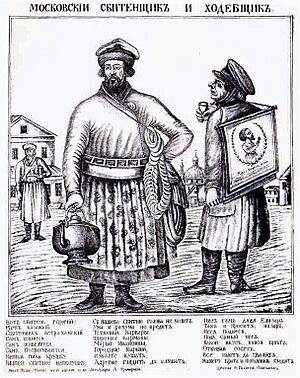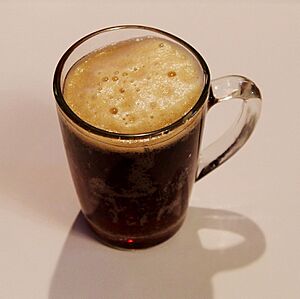Sbiten facts for kids
Sbiten (pronounced sbee-ten) is a traditional hot drink from Eastern Europe, especially Russia, Belarus, and Ukraine. It's usually dark purple and can be very spicy or very sweet, depending on how it's made. People often compare it to a warm, spiced drink like Glühwein, but sbiten usually doesn't have alcohol. Sometimes, modern sbiten is served cold in the summer or added to tea or coffee.
The History of Sbiten
Sbiten was first mentioned way back in 1128. It was a very popular drink for everyone in Russia until the 1800s. Around that time, coffee and tea became more common and took its place.
In the 1700s, sbiten was still as popular as tea and was a cheaper choice. Even Peter the Great, a famous Russian emperor, gave sbiten to the workers building his new capital city, Saint Petersburg. He did this to help them stay warm in the cold weather.
Russian sailors also drank sbiten in the 1700s and 1800s. They used it to help prevent scurvy, a sickness caused by not getting enough vitamin C. It was especially helpful when mixed with citrus or ginger juice.
After the Soviet Union ended, sbiten became popular again. It was often sold as a very sweet and spicy syrup in shops, especially those connected to monasteries. In 2018, Vladimir Putin, the president of Russia, even bought a bottle of sbiten and gave it to Xi Jinping, the leader of China.
How Sbiten is Made
Sbiten is made with honey mixed with water, spices, and jam. It's similar to other honey-based drinks like mead. A recipe for sbiten was even written down in a book called the Domostroy in the 1500s.
Making sbiten is quite simple. In some recipes, the honey and flavorings (like spices and fruit juices) are boiled separately. Then, these two parts are mixed and boiled together again. Other recipes just mix all the ingredients and boil them at once.
You can make sbiten even tastier by adding mint leaves or cinnamon sticks as a garnish.
Sbiten Sellers

In old Russia, people who sold sbiten were called sbitenshchik. They would shout out loud advertisements and sing short songs called chastushkas to get people's attention.
There were also khodebshchik who were mobile sbiten sellers. They carried their drinks through the streets. These sellers were usually strong people because they had to carry many glasses and a heavy metal pot full of warm sbiten.
A funny play called The Sbiten Vendor was very popular in Russia around the late 1700s and early 1800s. It was written by Yakov Knyazhnin with music by Antoine Bullant.
Sbiten sellers also helped create the samovar, a special kettle used for heating water for tea. In the 1700s, they invented something called a sbitennik. This was a type of kettle that could keep sbiten warm all the time, which was very useful for their business.
See also
In Spanish: Sbiten para niños


